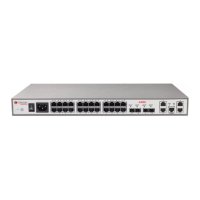A10E/A28E/A28F Configuration Guide
System chooses default interface in the order of neighbor discovery, interface
maximum speed, interface highest LACP priority, and interface minimum ID. The
interface is in active status by default, the interface with identical speed, identical
peer and identical device operation key is also in active status; other interfaces are
in standby status.
7.1.6 Checking configurations
Use the following commands to check configuration results.
Alpha-
A28E#show lacp
internal
Show local LACP interface status, tag, interface priority,
administration key, operation key, and interface status
machine status.
Alpha-
A28E#show lacp
neighbor
Show the peer LACP information, including tag, interface
priority, device ID, Age, operation key value, interface
ID, and interface status machine status.
Alpha-
A28E#show lacp
statistics
Show interface LACP statistics, including total number of
received/sent LACP packets, the number of received/sent
Marker packets, the number of received/sent Marker
Response packets, the number of errored Marker
Response packets,
Alpha-
A28E#show lacp
sys-id
Show global LACP enabling status of the local system,
device ID, including system LACP priority and system
MAC address.
Show configurations of all link aggregation groups.
7.1.7 Example for configuring manual link aggregation
Networking requirements
As shown in Figure 7-1, to improve link reliability between Switch A and Switch B, you
should configure manual link aggregation for the two devices. Add Port 1 and Port 2 into link
aggregation group to build up a unique logical interface. The link aggregation group performs
load sharing according to the source MAC address.

